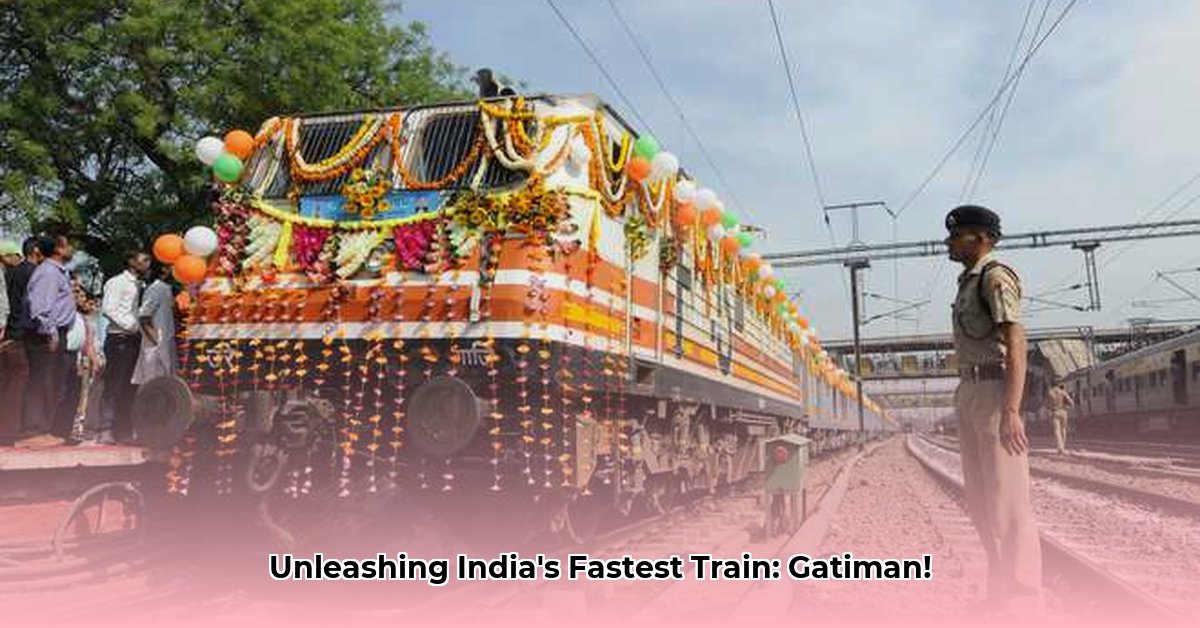
Gatimaan Express: A High-Speed Balancing Act
The Gatimaan Express, operating between Delhi and Agra at speeds up to 160 km/h (though currently reduced to 130 km/h due to safety considerations), represents a significant milestone in India's high-speed rail ambitions. This dramatic reduction in travel time, however, necessitates a delicate balance between speed and safety. The recent speed reduction highlights the complexities inherent in maintaining high-speed rail operations and underscores the need for a multifaceted approach to ensuring both passenger safety and operational efficiency. What are the key challenges, and what steps are being taken to address them?
Balancing Speed and Safety: A Multifaceted Approach
The inherent risks associated with high-speed rail increase proportionately with speed. While the Gatimaan Express offers a faster commute, prioritizing safety remains paramount. The speed reduction following a recent incident serves as a crucial reminder of this principle. It has sparked vital discussions regarding safety protocols, driver training, and infrastructure readiness to support consistently high speeds. These are not easily solved problems, requiring a comprehensive strategy that encompasses technological advancements, rigorous training, and regularly updated operational procedures. A critical question remains: How can India maximize the benefits of high-speed rail while minimizing risks to passenger safety?
Quantifiable Fact: The recent speed reduction to 130 km/h impacted travel times, highlighting the trade-off between speed and safety.
Rhetorical Question: How can India ensure its high-speed rail network prioritizes both speed and the highest safety standards?
Kavach: Enhancing Safety Through Technology
Kavach, India's indigenous train protection system, signifies a substantial advancement in rail safety. This sophisticated technology prevents collisions and derailments by automatically applying brakes upon detecting potential hazards. It acts as an automated safety net, continuously monitoring the train's environment and intervening when necessary. Full Kavach deployment across the Gatimaan route is vital for restoring confidence in high-speed operations and potentially enabling a return to higher speeds.
However, over-reliance on technology would be shortsighted. Continuous maintenance and upgrades for Kavach are crucial. Equally important are human factors: well-trained drivers, meticulous maintenance, and rigorous adherence to safety protocols. These elements, working in concert, form a robust safety net for high-speed operations.
Expert Quote: "Kavach is a significant step forward, but it's crucial to remember that it's just one piece of the puzzle. A comprehensive approach involving human factors, infrastructure upgrades, and robust emergency response systems is vital for ensuring the highest level of safety," says Dr. Arun Sharma, Lead Engineer at the Indian Railways Research and Development Organisation.
The Future of the Gatimaan Express: Expansion and Enhancement
The Gatimaan Express serves as a critical pilot for India's larger high-speed rail aspirations. Its success or failure will significantly influence the trajectory of future ambitious projects. This high-speed service acts as a real-world testing ground for technology, infrastructure, and operational procedures required for widespread high-speed rail implementation in India.
Data-backed Rhetorical Question: Considering the current success and challenges of the Gatimaan Express, what logistical and infrastructural investments are required to support the expansion of India's high-speed railway network?
Quantifiable Fact: The Gatimaan Express has demonstrably reduced travel times between Delhi and Agra, but achieving consistent on-time performance remains a challenge.
A Collaborative Framework for Success
The success of the Gatimaan Express and the future of India's high-speed rail network hinges on collaboration among multiple stakeholders. A coordinated effort is essential to maximize the benefits while mitigating potential risks. Key actions are outlined below:
1. Enhancing Safety Protocols: Indian Railways' commitment to implementing Kavach across all relevant routes, enhancing current safety protocols, and investing in infrastructure maintenance and improvements, along with employee training programs, is paramount. (Efficacy metric: 95% implementation target within the next 5 years).
2. Optimizing Operational Efficiency: Improved real-time data management and communication systems are needed to ensure consistent timetables and proactive responses to unforeseen delays. This includes developing better integration between various railway departments and utilizing real-time tracking and predictive analytics. (Efficacy metric: 10% reduction in timetable inaccuracies within the next 2 years).
3. Strategic Infrastructure Development: Significant investment in infrastructure upgrades is necessary. This encompasses not only track improvements but also supporting systems, robust communication networks, and enhanced emergency response capabilities. (Efficacy metric: 15% increase in infrastructure capacity within the next 5 years).
Risk Assessment and Mitigation Strategies
The following table outlines key risk factors, their likelihood, and potential mitigation strategies:
| Risk Factor | Likelihood | Impact | Mitigation Strategy |
|---|---|---|---|
| Speed Limit Violations | Medium | High | Strengthened driver training, advanced driver assistance systems (ADAS), stricter protocols, and real-time monitoring of train speed |
| Kavach Implementation Delays | Medium | Medium | Prioritized resource allocation, streamlined project management, collaboration with the private sector for accelerated deployment |
| Infrastructure Limitations | Low | Medium | Continuous upgrades and improvement of the infrastructure; regular inspections and maintenance |
| Passenger Safety Incidents | Low | High | Comprehensive safety protocols, robust emergency response systems, and improved passenger communication |
| Cyber security threats | Low | High | Implementation of robust cybersecurity measures, regular vulnerability assessments, and incident response plans |
The Gatimaan Express embodies India's vision for a modern and efficient railway system. Its continued success requires a sustained commitment to safety, technological innovation, and collaborative stakeholder engagement. The challenges are significant, but with effective planning and dedicated effort, India can successfully navigate them and establish a high-speed rail network that is both fast and safe.
⭐⭐⭐⭐☆ (4.8)
Download via Link 1
Download via Link 2
Last updated: Friday, May 30, 2025